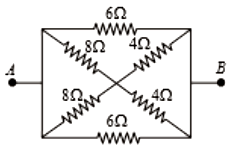Which of the following graph correctly represents the variation of mobility of electrons with applied electric field (E) in a metallic conductor?
1.

2.

3.

4.






To unlock all the explanations of this course, you need to be enrolled.

To unlock all the explanations of this course, you need to be enrolled.
In the circuit shown in the figure, the effective resistance between A and B is:

1. 2
2. 4
3. 6
4. 8

To unlock all the explanations of this course, you need to be enrolled.

To unlock all the explanations of this course, you need to be enrolled.
The drift velocity of free electrons in a conductor is \(v\) when a current \(i\) is flowing in it. If both the radius and current are doubled, then the drift velocity will be:
1. \(v\)
2. \(\frac{v}{2}\)
3. \(\frac{v}{4}\)
4. \(\frac{v}{8}\)

To unlock all the explanations of this course, you need to be enrolled.

To unlock all the explanations of this course, you need to be enrolled.
A battery has e.m.f. 4 V and internal resistance r. When this battery is connected to an external resistance of 2 ohm, a current of 1 ampere flows in the circuit. How much current will flow if the terminals of the battery are connected directly?
| 1. | 1 A | 2. | 2 A |
| 3. | 4 A | 4. | Infinite |

To unlock all the explanations of this course, you need to be enrolled.

To unlock all the explanations of this course, you need to be enrolled.
The equivalent resistance between \(A\) and \(B\) is:
1. \(3~\Omega\)
2. \(6~\Omega\)
3. \(9~\Omega\)
4. \(12~\Omega\)

To unlock all the explanations of this course, you need to be enrolled.

To unlock all the explanations of this course, you need to be enrolled.
The current I as shown in the circuit will be:

1. 10 A
2.
3.
4.

To unlock all the explanations of this course, you need to be enrolled.

To unlock all the explanations of this course, you need to be enrolled.
A meter bridge is set up to determine unknown resistance x using a standard 10 resistor. The galvanometer shows the null point when the tapping key is at a 52 cm mark. End corrections are 1 cm and 2 cm respectively for end A and B. Then the value of x is:

1. 10.2
2. 10.6
3. 10.8
3. 11.1

To unlock all the explanations of this course, you need to be enrolled.

To unlock all the explanations of this course, you need to be enrolled.
The current through the 5 resistor is:
1. 3.2 A
2. 2.8 A
3. 0.8 A
4. 0.2 A

To unlock all the explanations of this course, you need to be enrolled.

To unlock all the explanations of this course, you need to be enrolled.
The current in a wire varies with time according to the relation i= (3+2t) A. The amount of charge passing a cross section of the wire in the time interval t=0 to t=4.0 sec would be: (where t is time in seconds)
| 1. | 28 C | 2. | 30.5 C |
| 3. | 8 C | 4. | 82 C |

To unlock all the explanations of this course, you need to be enrolled.

To unlock all the explanations of this course, you need to be enrolled.
In the figure, a carbon resistor has bands of different colours on its body as shown. The value of the resistance is:
1. 2.2 k
2. 3.3 k
3. 5.6 k
4. 9.1 k

To unlock all the explanations of this course, you need to be enrolled.

To unlock all the explanations of this course, you need to be enrolled.





